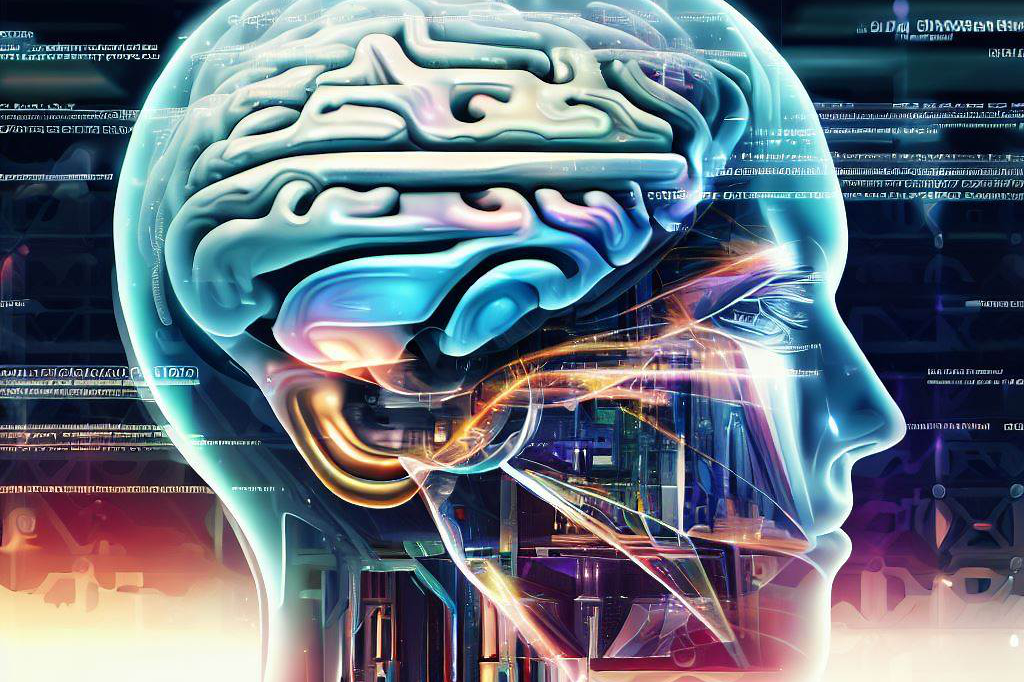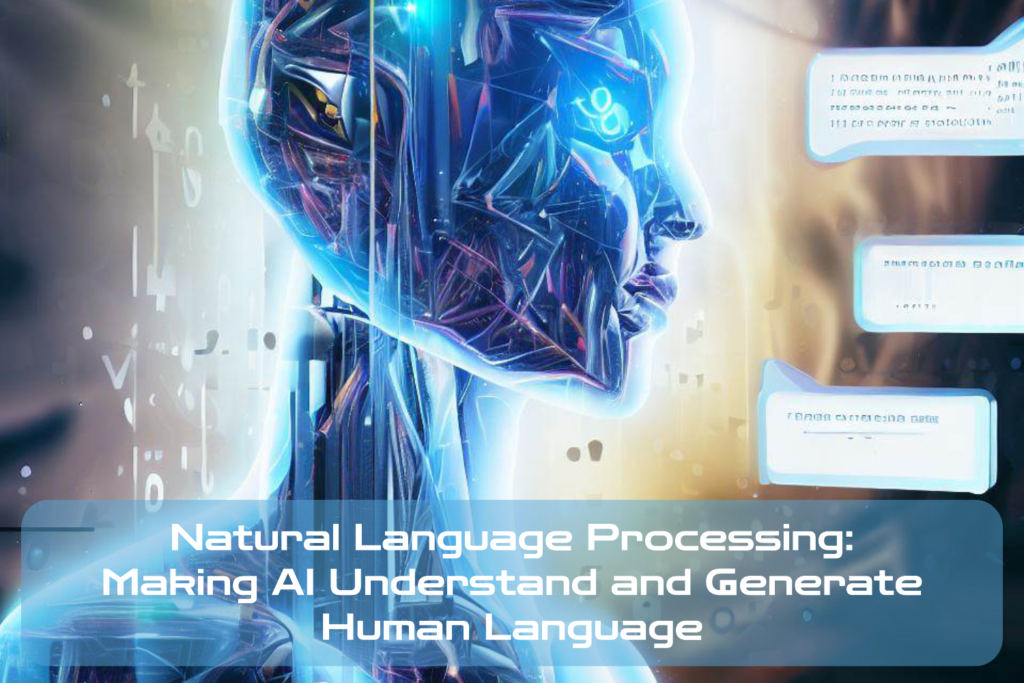Natural Language Processing (NLP) is a subfield of Artificial Intelligence (AI) concerned with the interaction between computers and human language. It involves the development of algorithms and models that enable machines to understand, interpret, and generate human language. NLP has become increasingly popular in recent years due to the proliferation of text-based data on the internet, such as
- emails,
- social media posts,
- news articles,
- and scientific documents.
Definition of Natural Language Processing (NLP)
NLP can be defined as a branch of computer science that deals with the interaction between computers and human language. It involves developing algorithms that can process natural language data in a way that is similar to humans.
The goal is to enable machines to understand and interpret human language at various levels, such as
- syntax,
- semantics,
- pragmatics,
- discourse analysis,
- sentiment analysis etc.
One important aspect of NLP is its focus on processing unstructured text data.
Unlike structured data found in databases or spreadsheets which have pre-defined fields or categories like names or addresses, text data presents multiple challenges for machine understanding due to its ambiguity and complexity.
For example homonyms like “bank” can refer both to financial institutions or riverbanks, and words with multiple meanings like “wood” can refer either to material used in construction or forested areas.
Importance of NLP in AI

The importance of NLP in AI stems from its ability to bridge the gap between machines and humans by enabling them to communicate more effectively. With advancements in machine learning algorithms coupled with vast amounts of text-based data generated every day makes it possible for computers not only to understand natural languages but also generate them. Applications include
- sentiment analysis which enables companies to track customer opinions about their products;
- chatbots which provide customer service and sales support;
- machine translation which helps people communicate across languages;
- speech recognition which enables hands-free control of devices etc.
Brief history of NLP

The history of NLP dates back to the 1950s when researchers began experimenting with using computers to translate languages. One of the first significant breakthroughs in NLP was the development of the first language model called “ELIZA” in 1966 by Joseph Weizenbaum which could simulate a conversation between a human and a computer.
Other important developments include the creation of rule-based systems for parsing natural language text in the late 1970s, followed by statistical models for analyzing text data in the early 1990s.
More recent advancements have been fueled by deep learning techniques such as recurrent neural networks (RNN), convolutional neural networks (CNN), and transformers which have helped improve system performance on various NLP tasks.
Understanding Human Language

Natural Language Processing (NLP) is an advanced discipline of artificial intelligence that teaches machines to understand and communicate in human language. In order to achieve this, NLP systems must first understand the structure and meaning of human language. This is a difficult task since language is incredibly complex and nuanced, but with the advancements in machine learning algorithms, NLP systems have become more sophisticated.
Syntax and Semantics
Syntax refers to the grammatical rules that govern how words are organized into sentences. It deals with the structure of sentences, including aspects such as word order, sentence length, punctuation, and grammatical agreements.
Semantics is concerned with the meaning of words and sentences. It deals with how words are used together to convey their meanings within the given context.
For example, consider the sentence “The cat climbed up the tree.”
The syntax here dictates that “the cat” is the subject followed by “climbed up” as a verb phrase while “the tree” functions as an object.
The semantics indicate that this sentence describes an action being performed by a specific feline on a particular tree.
Morphology and Phonology
Morphology is concerned with how words are formed from smaller units called morphemes. Morphemes can be roots or affixes (prefixes or suffixes) that modify their meanings or function in different ways within sentences.
Phonology focuses on sound patterns in human language, including how sounds combine to create syllables and words.
For instance, using morphology we can break down an inflected word like “walked,” which includes both root “walk” + past tense suffix “-ed.” Meanwhile, phonology explains why we say /wɔkt/ (with sound /t/) instead of /wɑ:kt/ (with sound /k/) by analyzing the underlying rules of English pronunciation.
Pragmatics and Discourse
Pragmatics is the study of how people use language in different situations to convey meaning beyond the literal interpretation of words. This includes aspects such as implied meanings, cultural references, and conversational implicatures.
Discourse analysis examines how language is used to create coherent texts or narratives over longer stretches of speech or writing.
For example, consider the phrase “Pass me that thing.” In a pragmatic sense, it could mean “Give me that object I’m pointing at using my body language” rather than simply requesting an unknown object. Meanwhile, discourse analysis can identify patterns in word choice across paragraphs or sections that show how an author gradually builds up a narrative arc in their writing.
Techniques for Natural Language Processing

One of the most important techniques in natural language processing is tokenization. Tokenization is a process where words and sentences are broken down into individual units called tokens. There are two types of tokenization: word tokenization and sentence tokenization.
Word Tokenization
Word tokenization involves breaking down a text into its individual words or terms. This technique works by identifying spaces and punctuation marks, such as commas, periods, semicolons, and colons, as the boundaries between words.
Word tokenization is important because it enables algorithms to identify the meaning behind each word in a text. For instance, consider the sentence “I saw her duck.” Without proper word tokenization, NLP algorithms would not be able to differentiate between “her duck” as a bird or “her duck” as an action.
Sentence Tokenization
Sentence tokenization involves breaking down a text into its individual sentences or clauses.
This technique works by identifying punctuation marks such as periods, exclamation points, and question marks as sentence boundaries. Sentence tokenization helps make sense of texts by enabling algorithms to analyze them one sentence at a time.
Part-of-Speech (POS) Tagging
POS tagging is another essential technique in natural language processing that involves classifying each word in a text according to its part of speech (noun, verb, adjective etc.). In addition to basic parts of speech tagging like nouns and verbs, POS tagging can also recognize named entities through Named Entity Recognition (NER), which identifies specific entities like people’s names or place names within texts.
The ability to accurately label parts of speech through POS tagging allows NLP algorithms to understand how different words function within sentences. For instance,
in the sentence “The cat chased the mouse,” POS tagging can identify “cat” as a noun and “chased” as a verb. This information helps algorithms understand the relationships between words in a sentence and how they work together to convey meaning.
Parsing and Dependency Parsing
Another technique in natural language processing is parsing, which involves analyzing the structure of sentences to determine their grammatical structure.
Constituency parsing identifies smaller parts of a sentence called constituents, such as phrases or clauses, while dependency parsing identifies the relationships between individual words.
Constituency Parsing involves breaking down sentences into smaller parts known as constituents. These smaller parts are often phrases, clauses, or sub-clauses that make up the composition of a given sentence.
By analyzing these constituent parts, algorithms can better understand how sentences are formed.
Dependency Parsing is another technique used to understand how words relate to each other within a given sentence.
Through this technique, an algorithm can form parses that are based on the relationship between two adjacent words within a given text. By using this information to form dependencies within text data sets (such as those found in social media feeds), we may be able to gain insights into patterns of behavior among user populations.
Techniques like tokenization, part-of-speech tagging (POS), constituency parsing and dependency parsing have revolutionized our ability to process and analyze languages at scale.
As NLP continues to advance with machine learning powering more sophisticated algorithms for natural speech processing at scale with higher accuracy rates than ever before imaginable, we find ourselves closer than ever before towards achieving true human-like language proficiency in machines – bringing us one step closer towards realizing futuristic sci-fi dreams of talking robots that truly understand what we say!
Applications of Natural Language Processing

Natural Language Processing (NLP) has numerous applications that are becoming increasingly popular across different industries. In this section, we will discuss three of the most common applications of NLP:
- Sentiment Analysis and Opinion Mining,
- Machine Translation,
- and Chatbots and Virtual Assistants.
Sentiment Analysis and Opinion Mining
Sentiment analysis or opinion mining is the process of extracting subjective information from text data. It involves identifying the opinions, attitudes, emotions, and sentiments expressed in a piece of text. Applications for sentiment analysis include analyzing customer feedback on social media or product reviews to gain insights into consumer behavior.
Sentiment analysis algorithms typically categorize text as positive, negative or neutral based on keywords or phrases used in the text. Opinion mining goes beyond sentiment analysis by identifying specific aspects of a product or service that customers like or dislike.
For instance, opinion mining can detect when customers express dissatisfaction with the price, customer service, or delivery time. By understanding customers’ opinions about products/services better businesses can improve their services to meet customer needs.
Machine Translation
Machine translation is an application of NLP that involves automatically translating one language into another language. The goal is to make communication easier between people who speak different languages.
Machine translation systems use statistical models to learn patterns between words in different languages then use these models to translate sentences accurately. Machine translation has numerous benefits for individuals and organizations alike;
- it enables businesses to expand globally by having multilingual websites without needing human translators;
- it also makes cross-cultural communication easier by enabling individuals speaking different languages to communicate without the need for human translators.
Chatbots and Virtual Assistants
Chatbots and virtual assistants are AI-powered tools that interact with users via natural language conversations. They are designed to understand user intentions correctly and provide relevant responses based on those intentions.
Chatbots are commonly used in customer support services to answer frequently asked questions, make bookings, or provide product recommendations.
Virtual assistants, on the other hand, are more advanced and can perform more complex tasks such as scheduling meetings or sending reminders.
Chatbots and virtual assistants are becoming increasingly popular because of their ability to save time and improve customer satisfaction. They can handle numerous interactions simultaneously which reduces the waiting time for customers, thus improving the overall user experience.
Challenges in Natural Language Processing

Natural Language Processing (NLP) is a rapidly advancing field with applications in various domains, from chatbots and virtual assistants to machine translation and sentiment analysis. However, despite the remarkable progress made so far, there are still several challenges that researchers face in making AI understand and generate human language.
Ambiguity in Language Interpretation
Ambiguity is one of the most significant challenges in natural language processing. Words can have multiple meanings depending on the context in which they are used, making it difficult for machines to interpret them accurately.
For example, consider the word “bank.” It can refer to a financial institution or a riverbank. Without context, it is challenging to determine which meaning is intended.
To address this challenge, researchers have developed techniques such as named-entity recognition and coreference resolution that help machines identify entities referred to by multiple expressions throughout a document. Another approach involves using machine learning algorithms trained on large datasets of annotated text that enable machines to learn contextual associations between words.
Lack of Context Understanding
Contextual understanding is essential for interpreting language correctly. Humans rely on their knowledge of real-world events and experiences when interpreting language and inferring meaning from it. However, machines lack this knowledge and experience, making it difficult for them to understand the nuances of human language accurately.
One approach that has been used to address this challenge involves incorporating external knowledge sources such as ontologies and semantic networks into NLP models. These sources provide additional context that helps machines make more accurate interpretations of language.
Cultural Differences
Cultural differences pose yet another challenge in natural language processing. Language use varies across cultures and regions; what may be considered polite or appropriate in one culture may not be so in another culture. For example, expressions used in English-speaking countries may have different connotations or meanings in non-English speaking countries.
To address this challenge, researchers have developed cross-cultural NLP models that account for variations in intercultural communication. These models use machine learning algorithms trained on multilingual datasets and incorporate cultural knowledge and linguistic rules specific to each culture.
While natural language processing has made significant progress over the years, several challenges still exist that need to be addressed. Researchers must continue to develop innovative techniques and approaches that enable machines to understand and generate human language accurately despite the complexities of ambiguity, context understanding, and cultural differences.
Future of Natural Language Processing in AI

Advancements in Machine Learning Algorithms: Unlocking the Potential of NLP
The future of natural language processing (NLP) in artificial intelligence (AI) is bright, and it is mainly due to the rapid advancements being made in machine learning algorithms. Traditional NLP models heavily relied on hand-coded rules that were limited by their rigid structure and lacked the flexibility to handle variations in human language. However, with the development of deep learning techniques such as neural networks and recurrent neural networks, NLP models can now learn from vast amounts of data and adapt to new languages or contexts quickly.
The use of pre-trained models like BERT and GPT-4 has significantly improved performance on many NLP tasks such as sentiment analysis, text classification, and machine translation. These advancements also allow for more sophisticated applications like generating contextually relevant responses for chatbots or virtual assistants.
Integration with Other Technologies: Expanding the Scope of NLP
Natural Language Processing is not an isolated field. Integration with other technologies will be crucial for expanding its scope beyond traditional areas like machine translation or sentiment analysis. For instance, combining computer vision with NLP can enable machines to understand natural language descriptions of images accurately.
This integration can lead to better search results for image queries or more accurate labeling in automated image recognition systems. Apart from computer vision, NLP integration with other emerging technologies like Robotics or IoT can open up new possibilities for intelligent automation systems that can understand human input through natural language commands.
Final Thoughts

Natural Language Processing is a rapidly evolving field that has already shown significant potential to transform many industries through improved communication between humans and machines. Advancements in Machine learning algorithms have unlocked the potential for more sophisticated applications featuring contextual understanding while Integration with other technologies will expand its scope beyond traditional areas. The future of Natural Language Processing is bright, and as AI continues to evolve, so too will our ability to understand and generate human language.

C M, a seasoned editor, journalist, and consultant, is deeply fascinated by the convergence of technology, space, and the future of humanity.
With a particular interest in transhumanism, futurology, and the philosophical and ethical dimensions of these domains, C M serves as the lead contributor to TranscendSphere and SpaceSpotlight.
When not penning insightful articles on these rapidly evolving fields, C M indulges in their love for podcasts and books, proudly embracing their status as a ‘Happy Nerd Extraordinaire!’





